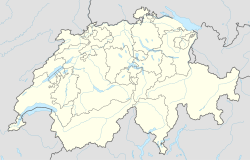Jeuss
| Jeuss | ||
|---|---|---|
| Former municipality of Switzerland | ||
|
||
| Coordinates: 46°54′N 7°10′E / 46.900°N 7.167°ECoordinates: 46°54′N 7°10′E / 46.900°N 7.167°E | ||
| Country | Switzerland | |
| Canton | Fribourg | |
| District | See or du Lac | |
| Government | ||
| • Executive |
Gemeinderat with 5 members |
|
| • Mayor | Ammann | |
| Area | ||
| • Total | 1.77 km2 (0.68 sq mi) | |
| Elevation | 544 m (1,785 ft) | |
| Population (Dec 2014) | ||
| • Total | 422 | |
| • Density | 240/km2 (620/sq mi) | |
| Postal code | 1793 | |
| SFOS number | 2264 | |
| Surrounded by | Cressier, Staatswald Galm, Gurmels, Salvenach | |
| Website |
www SFSO statistics |
|
Jeuss (Jentes in French) is a former municipality in the district of See or du Lac in the canton of Fribourg in Switzerland. On 1 January 2016 the former municipalities of Courlevon, Jeuss, Lurtigen and Salvenach merged into Murten.
Jeuss is first mentioned in 1340 as Juentes.
Jeuss had an area, as of 2009[update], of 1.8 square kilometers (0.69 sq mi). Of this area, 1.42 km2 (0.55 sq mi) or 79.8% is used for agricultural purposes, while 0.19 km2 (0.073 sq mi) or 10.7% is forested. Of the rest of the land, 0.15 km2 (37 acres) or 8.4% is settled (buildings or roads), 0.01 km2 (2.5 acres) or 0.6% is either rivers or lakes.
Of the built up area, housing and buildings made up 5.1% and transportation infrastructure made up 2.8%. Out of the forested land, 8.4% of the total land area is heavily forested and 2.2% is covered with orchards or small clusters of trees. Of the agricultural land, 69.7% is used for growing crops and 9.6% is pastures. All the water in the municipality is flowing water.
The former municipality is located in the See/Lac district, on a gravelly terrace between the Biberen valley and Galm forest. It consists of the linear village of Jeuss.
The blazon of the municipal coat of arms is Azure, a Hive Or issuant from a Base Vert.
Jeuss had a population (as of 2014[update]) of 422. As of 2008[update], 7.7% of the population are resident foreign nationals. Over the last 10 years (2000–2010) the population has changed at a rate of 44.4%. Migration accounted for 26.4%, while births and deaths accounted for 9.5%.
...
Wikipedia



